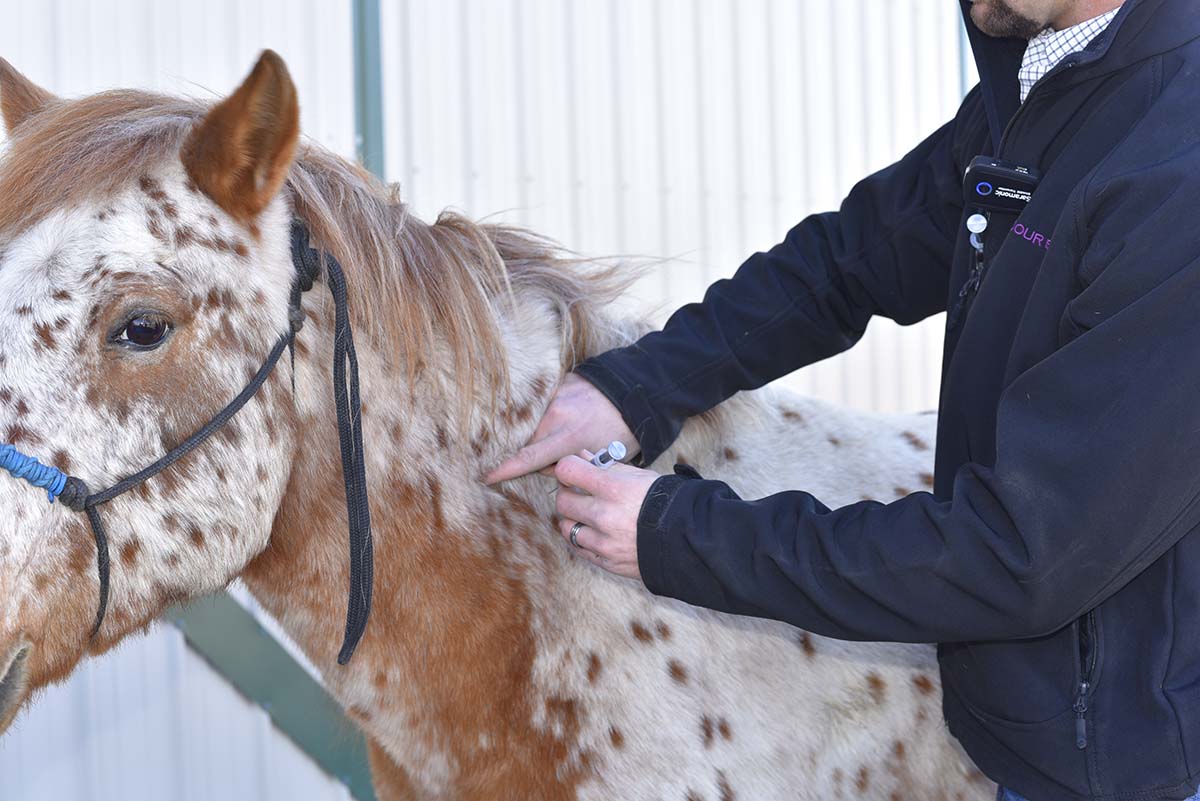
Disease symptoms, transmission and prevention, as described by an entomologist and veterinarian.
It was early in the mosquito season when a young cutting horse, who had just started training, became inflicted with West Nile virus.
“The horse didn’t know where he was placing his feet, and his gait was off. When the bloodwork came back, it ended up being West Nile,” said Tony Hawkins, DVM, Valley Vet Supply Technical Service Veterinarian. “It’s such an easy disease to prevent – as long as the horse is properly vaccinated, you don’t get any breakthrough infections.”
With about 10 weeks of treatment, the gelding survived and made a full recovery, which can be rare.
“Not many horses will recover fully. While the survival rate is high (67%), there can be some lasting side effects,” said Dr. Hawkins.
Since 1999, more than 25,000 cases of WNV encephalitis have been reported in U.S. horses, according to the American Association of Equine Practitioners (AAEP). Even more, horses represent 96.9% of all reported non-human mammalian cases of WNV disease.
With mortality rates reaching up to 90% from mosquito-transmitted diseases, it’s important that horses be protected.
“The three big core equine diseases transmitted by mosquitoes are West Nile virus, Eastern equine encephalomyelitis (EEE), and Western equine encephalomyelitis (WEE). Venezuelan equine encephalomyelitis (VEE) isn’t typically a problem, but there have been years with outbreaks in specific areas,” warns Dr. Hawkins.
These diseases can attack and inflame a horse’s nervous system – beware the wide range of symptoms a horse can demonstrate.
WNV Symptoms
- Depression
- Low-grade fever (101.5–103.5° F)
- Lethargy
- Sudden neurologic challenges
- Twitching of the muzzle and ears
- Excitability, apprehension, and/or sleepiness
- Tremors of the face and neck muscles
- Facial paralysis
- Head tilt and/or drooping lip
- Weakness in limb(s)
- Complete or partial paralysis of limbs
- Frequent chewing
- Aggression
- Colic
- Death
EEE/WEE/VEE Symptoms
- High fever (more than 103° F)
- Severe depression
- Suppressed appetite
- Walking aimlessly, often circling
- Pressing their head into corners
- Changes in behavior
- Vision impairment
- Muscle twitches
- Inability to swallow
- Paralysis
- Confusion of surroundings
- Death
The Buzz about Disease Transmission
EEE, WEE and VEE are spread to horses by mosquitoes, which feed on infected birds and rodents that serve as the virus reservoirs. WNV is transmitted by mosquitoes, which feed on infected birds.
Justin Talley, PhD, Department Head for Entomology and Plant Pathology at Oklahoma State University – who previously worked as a livestock entomologist – explained more.
“Basically, when we talk about West Nile virus, we’re talking about the Culex mosquito, which was introduced into the U.S. from the Old World during the start of global trade,” said Dr. Talley. “Since, the Culex mosquito has adapted well. The biggest challenge is that in addition to feeding on horses, they are also feeding on birds, which is why they’re so good at transmitting the virus into the horse and human population, making them the dead-end host. Once the virus gets into either a horse or human, it doesn’t get into another person.”
As far as seasonality goes, Dr. Talley says you’ll generally see more mosquitoes in late summer or in the fall. The number of cases year-to-year is unpredictable and will vary, depending on the bird population. The disease cycle is dependent on that bird-mosquito relationship.
“It’s a cyclical pattern,” Dr. Talley says. “There’s a multitude of birds that can host West Nile virus, and when more birds come around is generally when we start seeing active infections. The mosquitoes feed on the birds that have that infection, and an incubation period goes through the mosquito. Then the mosquito becomes the active vector which can transmit West Nile virus into the horse.”
The virus has been documented throughout the continental United States, as well as Mexico and Canada – thus, all horses are at risk if they are unprotected.
Shield Horses from Their Harm
Moving air plays an important part in mosquito control. “Mosquitoes are weak fliers, they can’t fly through moving air,” said Dr. Hawkins. “As much moving air as you can design into your barn and your horse’s stalls will be helpful in preventing them from landing and taking a blood meal from your horse. For barn fire prevention, be sure you’re using a livestock fan with an enclosed, protected motor, instead of a box fan. A true livestock fan will also move more air, deterring mosquitoes – and flies, too.”
In addition to moving air, never underestimate the importance of vaccinations and good barn-keeping. “It’s important to stay on top of your West Nile virus vaccine and boosters,” Dr. Talley said, also recommending that horse owners eliminate standing water to deter mosquito breeding habitats, as well as regularly clean a horse’s water trough.
Horses are continually exposed to the environment, wildlife and mosquitoes that transmit the five core equine diseases.
“It is important to follow the AAEP core equine disease vaccination protocol,” said Dr. Hawkins. “Make sure horses are vaccinated yearly against Eastern and Western Equine Encephalomyelitis, West Nile virus, rabies, and tetanus.”
Visit ValleyVet.com to continue learning about horse health.
About Valley Vet Supply
Valley Vet Supply was founded in 1985 by veterinarians to provide customers with the very best animal health solutions. Building on over half a century of experience in veterinary medicine, Valley Vet Supply serves equine, pet and livestock owners with thousands of products and medications hand-selected by Valley Vet Supply Technical Service veterinarians and team of industry professionals. With an in-house pharmacy that is licensed in all 50 states, and verified through the National Association of Boards of Pharmacy (NABP), Valley Vet Supply is the dedicated source for all things horse, livestock and pet. For more information, please visit ValleyVet.com.
Find more interesting articles in our section on Health & Education.

































